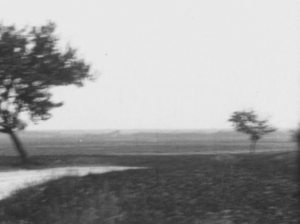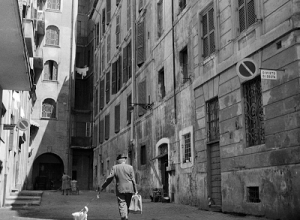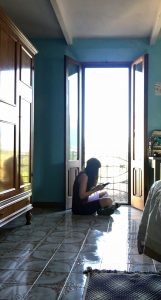da Le Caselle (Pietrafitta) a Sora

The work that will come out of the La Mola residency is inspired by two films. The first is an intentional choice; Walking from Berlin to Munich (1927) by Oskar Fischinger, is a structurally straightforward, short, and beautiful film, whose subject matter is exactly as the title describes. In this stand-alone work, Fishinger walked, and took single frame shots (which sometimes come together to form segments of motion) of what he saw along the road between the two cities, including people, buildings, and land forms.
I wanted to create a project using the structure of Fischinger’s film. My visual and audio practice is influenced by film; the material itself, a specific film or excerpted element, a cinematic concept, or some combination of the three always provide the starting point. Both as a programmer and as an independent viewer, I experience film as visual art always and narrative storytelling sometimes, but in my work as an artist film is visual art always, and narrative storytelling almost never. Quasi mai.
My original plan was to create a film using the same structure and technique as Fischinger’s, using the La Mola residency site as the starting point, and walking to Rome. The Pietrafitta to Roma walking journey couldn’t happen though, not only because of logistical difficulties—the distance would have taken up more time than allotted for the residency—but, as Artarcadia founder Paola Bernardelli pointed out to me, the road to Rome is dangerous, for many reasons, for a woman travelling alone. Fishinger’s passeggiata had taken three weeks. I hadn’t the time or resources for something comparable. Instead, Paola suggested Sora as the second city. Only a day’s journey, we could go together, and the final destination in that town would be the family home of Vittorio De Sica.

Since selecting Rome as the second city in the Berlin to Munich structure had essentially been an arbitrary choice (it was the only place I knew in the region close to La Mola), this became the plan. In fact, Sora was also a suitable alternative for another reason. I had excerpted sounds from De Sica’s Umberto D in one of my earliest film experiments—the sounds of footsteps in hallways and closing doors—and these are much like the domestic sounds that I am now recording in the house at the La Mola site. So, by chance Umberto D has become another point of reference.

I’ve been using a portable digital recorder to capture mostly night sounds in Pietrafitta. In the surrounding Apennine valley there are many species of birds unfamiliar to me, and I’ve had some assistance from Paola and locals in identifying the creatures that have ended up on some of the night recordings. Sitting on the roof last night, we were listening and Paola pointed out the sound of traffic from the larger roads, which to my ears had been completely inaudible up to that point because of all of the other fascinating, and to me unidentifiable sounds filling the valley. The recordings will eventually be incorporated into the Winnipeg installation.
Although I’ve been recording mainly at night, I’ve had the opportunity to record some daytime domestic activities indoors, and the sound of footsteps moving up and down the many marble staircases in the three storey house. I’ve also recorded the sound of my own footsteps traversing the entire village, with the large audial contrast that occurs when stepping out from between stone buildings facing one another on the narrow road, and areas that are open entirely to the valley.

On Saturday we will make the 27 kilometre journey on foot from La Mola to Sora. Paola’s friend Tonino, a local historian, polymath, and De Sica enthusiast, appeared the other afternoon with a book on De Sica for me, and pointed out to us that the side road route that we would be taking (which had been suggested to us by Paola’s cousin due to its abundance of shade), is actually an ancient path, which goes by necessity from fountain to fountain.
Following Fischinger’s structure, I will take single frame photographs along the route, and also plan to make audio recordings using the same staccato technique.
The final project will involve two components—
- A sound installation/screening in a site specific venue of the La Mola to Sora film and audio recordings. With the assistance of Theo Sims of Winnipeg-based LICA, I have toured a cinema that would be ideal for this purpose, in hopes of having its immense projection booth open to the public as well as part of the installation.
- A series of collages based on photographs taken on the walking journey. I’ll describe this second component in more detail in the next post.

